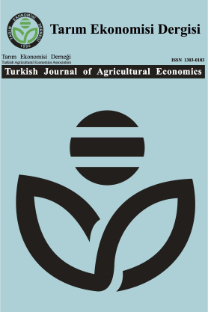Tüketicilerin Yöresel Ürün Satın Alma Davranışları: DAP Bölgesi Ürünleri
yöresel ürün, coğrafi işaret, tüketici tercihi, DAP Bölgesi
Local Product Purchasing Behaviours of Consumers: DAP Region Products
Regional product, geographical indication, consumer preference, DAP Region,
___
- Agarwal, S. And M.J., Barone, 2005. Emerging Issues for Geographical Indication Branding Strategies, Matric Research Paper, Iowa State University, USA.
- Albayram, Z., Mattas, K., & Tsakiridou, E. (2014). Purchasing local and non-local products labeled with geographical indications (GIs). Oper Research International Journal (2014); 14,, 237 - 251.
- Albisu, L. M. and K. Corcoran, 2001. Agro-food Business Strategies for Origin Labelled Products, Agrarwirtschaft 50 (2001), Heft 6, pp. 362 – 367.
- Anonim 2003. Geographical Indications, Discussion Paper, International Food & Agricultural Trade, Policy Council, USA.
- Anonim 2004. Why do Geographical Indications Matter to Us? EU Background Note, February 2004, Brusells.
- Babcock, B. A., 2003. Geographical Indications, Property Rights, and Value-Added Agriculture, Iowa Ag Review: Vol. 9 : Issue 4, Article 1.
- Baizyldayeva, U.B., R.K. Uskenbayeva and S.T. Amanzholova, 2013. Decision Making Procedure: Applications of IBM SPSS Cluster Analysis and Decision Tree, World Applied Sciences Journal 21 (8): 1207-1212.
- Beşirli, H., 2010. Yemek, Kültür ve Kimlik, Milli Folklor Dergisi, Yıl: 22, Sayı: 87, 159 – 169.
- Broude T., 2005. Taking “Trade and Culture” Seriously: Geographical Indications and Cultural Protection in WTO Law, Journal of International Economic Law, University of Pennsylvania, Vo: 26:4, 623 – 692.
- Cei L., Defrancesco E., Stefani G., 2018. From geographical indications to rural development: A review of the economic effects of European Union policy, Sustainability (Switzerland), 10 (10) , art. no. 3745.
- Chever, T., C. Renault, S. Renault, and V. Romieu, 2012. Value of production of agricultural products and foodstuffs, wines, aromatised wines and spirits protected by a geographical indication (GI), European Commission, No: AGRI–2011–EVAL–04, Final Report.
- DAP, 2016. DAP Bölgesi Yöresel Ürünlerini Ticarileştirme Stratejilerinin Belirlenmesi Projesi, T.C. Kalkınma Bakanlığı Doğu Anadolu Projesi Bölge Kalkınma İdaresi Başkanlığı ve Tübitak – Tüsside, Yayınlanmamış Proje Raporu, Erzurum.
- Deselnicu O. C., M. Costanigro, D. M. Souza-Monteiro and D. T. McFadden, 2013. A Meta-Analysis of Geographical Indication Food Valuation Studies: What Drives the Premium for Origin-Based Labels?, Journal of Agricultural and Resource Economics 38(2):204 – 219.
- Dokuzlu, S., J.C. Pons and M. Roggia, 2018. Support to the Development of Geographical Indications in the Bursa Region, Turkey and the Promotion of Local Exchange of Lessons Learned, Yayınlanmamış Proje Raporu, Bursa.
- Gracia, A. and Albisu, L.M., 2001. Food Consumption in the European Union: Main Determinants and Country Differences, Agribusiness: An International Journal, 17 (4).
- Gracia, A., 2014. Consumers’ preferences for a local food product: A real choice experiment. Empirical Economics, (47) 111 - 128.
- Green, P.E., D.S. Tull and G. Albaum, 1988. Research for Marketing Decisions. Fifth Edition, Prentice-Hall, Englewood Cliffs, NJ. 784 p.
- Jefferson-Moore, K. M., Robbins, R. D., Johnson, D., & Bradford, J., 2014. Consumer Preferences for Local Food Products in North Carolina. Journal of Food Distribution Research, Volume 45, Issue 1, 41 - 46.
- Kadanalı, E., S. Tercan ve V. Dağdemir, 2016. Tüketicilerin Yöresel Gıda Ürünleri Tercihi: Erzurum İli Örneği, XII. Ulusal Tarım Ekonomisi Kongresi, 25 – 27 Mayıs 2016, Bildiriler, s. 663 – 672.
- Karagölge, C. ve K. Peker, 2002. Tarım Ekonomisi Araştırmalarında Tabakalı Örnekleme Yönteminin Kullanılması, Atatürk Üniversitesi Ziraat Fakültesi Dergisi, 33 (3), sf. 313-316, Erzurum.
- Kılıç, S., 2013. Örnekleme Yöntemleri, Journal of Mood Disorders Volume: 3, Number: 1, 2013 - www.jmood.org
- Knight, A. J., 2013. Evaluating local food programs: The case of Select Nova Scotia. Evaluation and Program Planning, 36, 29 - 39.
- Loureiro, M. L., & McCluskey, J. J. 2000. Assessing Consumer Response to Protected Geographical Identification Labeling. Agribusiness, Vol. 16, No. 3, 309 - 320.
- McFadden, D. T. (2015) What Do We Mean by “Local Foods”? The Magazine of Food, Farm, and Resource Issues, 30 (1), 1 - 6.
- Steenkamp, Jan-Benedict E.M. and Martijn G. de Jong, 2010. A Global Investigation into the Constellation of Consumer Attitudes toward Global and Local Products, Journal of Marketing, 74 (November), 18-40.
- TPMK, 2018. Türk Patent ve Marka Kurumu, Coğrafi İşaret İstatistikleri http://www.turkpatent.gov.tr/TURKPATENT/
- Tregear, A., 2001. OLP Sector in United Kingdom, Development of Origin Labelled Products: Humanity, Innovation and Sustainability, University of Newcastle, Project Report, UK.
- Tregear, A., Arfini, F., Belletti, G. and Marescotti A., 2007. Regional Foods and Rural Development: the Role of Product Qualification, Journal of Rural Studies, 23, 12–22.
- Vandecandelaere, E. 2016. Geographical indications: a tool for supporting sustainable food systems”, in "Intellectual Property Rights for Geographical Indications: What is at stake in the TTIP? Arfini F., Mancini M.C., Veneziani M. and Donati M. eds.: Cambridge Scholars Publishing.
- Vandecandelaere, E., Afrini, F., Belletti, G., & Marescotti, A. 2010. Linking People, Places and Products. A Guide for Promoting Quality Linked to Geographical Origin and Sustainable Geographical Indications. Rome, Italy: FAO & SINERGI.
- Vats, N.K., 2016. Geographical indication-the factors of rural development and strengthening economy, Journal of Intellectual Property Rights. (Journal of Intellectual Property Rights, September-November 2016, 21(5-6):347-354.
- Webb, J. R., 1992. Understanding & Designin Marketing Research, Academic Press Limited, 236 p. UK.
- WTO, 2014 Uruguay Round Agreement: TRIPS Part II — Standards concerning the availability, scope and use of Intellectual Property Rights http://www.wto.org/english/docs_e/legal_e/27-trips_04b_e.htm
- ISSN: 1303-0183
- Yayın Aralığı: Yılda 2 Sayı
- Başlangıç: 1992
- Yayıncı: Tarım Ekonomisi Dergisi
Overall Economic Performance of Farms in Burkina Faso: Case of Maize
Plastik Serada SivrBiber Üretiminin Teknik Etkinliği: Mersin İli Örneği, Türkiye
Emre TORGUT, Serdar ANNAYEV, Murşide Çağla ÖRMECİ KART, Berna TÜRKEKUL
İzmr'n Kentsel Kesmnde Sera Sebzeler Tüketmnn Analz
Gizem ÖZÇINGIRAK, Sait ENGİNDENİZ
Türkiye'de Coğrafi İşaretli Gıda Ürünlerinin Gurme Turizmi Açısından Önemi
Bilal BİLGE, Nevin DEMİRBAŞ, Metin ARTUKOĞLU
Türkiye Turunçgiller İhracatının Rekabet Gücünün Analizi
Gıda ve İçecek Tüketmnde Yen Trendlern Değerlendrlmes
Türkye Turunçgl İhracatının Rekabet Gücünün Analz
Türkiye'de Gelirin Gıda Tüketimi Üzerindeki Etkisi
Alper DEMİRDÖĞEN, Emine OLHAN, Gökhan AYKAÇ
Tarım İşletmelerinde Sürdürülebilirliğin Ölçülmesi: Aydın İli Örneği
